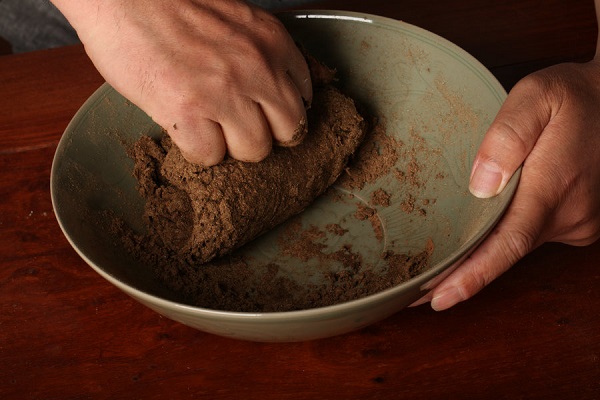young artisans revive curative benefits of chinese incense

all aromatic ingredients are ground into a fine powder to ensure even burning and a smooth texture. they are then rolled into a dough-like consistency. after drying the uneven ends are trimmed, and the sticks are smoothed. [photo provided to china daily]
history's ashes
the history of incense in china dates back to the spring and autumn period (770-476 bc) and the warring states period (475-221 bc), when it was used for ceremonial and religious purposes, according to the website of the china incense culture research center, an organization under the china folklore society.
incense held a central place in buddhist and taoist rituals — often symbolizing purity and reverence — and was burned when prayers were offered. as buddhism spread in china during the tang dynasty (618-907), incense became a common aroma in temples and households.
burning incense extended beyond religion, infiltrating daily life as the practice came to symbolize a connection to the natural and spiritual worlds.
the song dynasty (960-1279) saw incense evolve into a refined art form known as xiangdao, or "the way of incense", which involved making and enjoying incense in a mindful and contemplative manner.
scholars and social elites held incense appreciation gatherings, where they would carefully evaluate and compare different scents, discuss poetry, and engage in philosophical debates. the song dynasty also marked the peak of incense craftsmanship, with artisans creating elaborate incense burners, aromatic blends, and intricate rituals for enjoying a variety of fragrances.
lingering tradition
in the family workshop in zhoushan, weng was taught how to make incense by his father, who specialized in producing incense for religious rituals.
weng graduated from university in 2012 with photography major, but decided to focus on creating incense blends rooted in traditional chinese medicine, aiming to bring a holistic approach to personal wellness.
ancient chinese incense, he discovered, was closely tied to tcm and philosophy. the earliest forms of incense weren't for temples or religious spaces, but for herbal remedies that were heated to release therapeutic scents. in traditional belief, herbs' medicinal properties could be absorbed through inhaling their aromas, improving health and bringing balance to the body.
this approach, called hexiang, emphasizes harmony among different herbs, and balances elements in a way similar to a carefully prepared medicinal formula.
the idea of hexiang harmony comes from ancient texts, weng said, where it's described as blending herbs "as a doctor would prescribe a remedy, letting each ingredient's essence shine without overpowering the others."
many ingredients, like agarwood, clove, and sandalwood, were selected for their therapeutic effects. sandalwood, for instance, is believed to warm the body, which can help support kidney health and improve energy flow. other herbs like mugwort and cinnamon are associated with calming properties or respiratory health.
for weng, this concept of harmony provided a framework for his work.
"in traditional incense making, just like in chinese medicine, balance is key," he said. "some ingredients warm the body, while others cool it. by finding the right ratios, you can create something that promotes well-being while being beautiful to experience."
as he dove deeper, weng began studying ancient texts on herbs and traditional recipes, combining his father's practical knowledge with his own research. he learned that incense making requires precise methods and preparations that resemble making traditional chinese medicines.
for instance, the herb rhubarb, often used for its earthy aroma, needs to be soaked overnight in rice wine to soften its intensity.
sandalwood has a "dry heat", which can irritate if unprocessed. to temper it, weng soaks it in honey or green tea before slowly roasting it. this intricate preparation reflects knowledge of how each herb interacts with both the body and other ingredients.
"each herb has its own properties, its own way of expressing itself," weng said. "if you simply mix them, you won't get a harmonious blend. it takes time, patience, and a certain respect for the ingredients to bring out their best."
modern twist
the art of hexiang, as weng sees it, lies in making these traditional scents desirable in a modern context while preserving their wellness benefits.
he has created new incense products with his own twist, like blends for sleep, relaxation, or sharper focus, that are designed with the younger generation in mind. "to revive traditional culture, you have to bring it into people's lives in a way that feels relevant and relatable," he said.
this year, weng has been encouraged by a new wave of young people exploring traditional wellness practices. many of his customers are drawn to incense as a way to reduce stress and reconnect with their cultural heritage.
"the more i share my knowledge, the more i see people — especially young people — taking an interest," he said.
zhang junfeng, 23, is also dedicated to making incense. after graduating from the xi'an academy of fine arts with an art education major, he returned to his home in yantai, shandong province, and launched his own incense brand.
zhang said he sensed the younger generation's rising interest in chinese incense, especially as more people faced the pressures of urban living, demanding work schedules, and the pervasive digital environment. "as the scent fills the room, it creates a sensory refuge, helping users to center themselves and let go of daily tensions," he explained.
traditional chinese incense is crafted with care and patience, zhang said.
the process begins by finely grinding each ingredient into a powder. this powder is then carefully mixed with a natural binder — often honey or water — and shaped into coils, sticks, or cones.
from a young age, zhang was fascinated by the subtle beauty and fragrance of plants. as he grew older, this passion evolved into an interest in traditional chinese incense.
"when i was 14, i tried to make a specimen from some mint leaves. as i heated the leaves, i smelt the fragrance, which inspired me to try more plants," he said.
zhang said his mother loves using incense at home and when he was 20, he made his first osmanthus-scented incense stick for her. "now, my mother uses incense handmade by me," he said, adding that the incense scents he creates are named after lines from traditional chinese poems.
his business partner is a computer science major, and the pair have developed and launched an incense fragrance calculator.
noticing the growing interest among his peers for personalized experiences, zhang envisioned a tool that would allow young people to craft their own scents.
"users can select base ingredients, such as sandalwood or lavender, and complementary notes like citrus or spices," he said. "the calculator not only suggests ratios for a balanced fragrance but also educates users on the aromatic properties and the historical significance of each ingredient.
"we want to empower the young generation to engage with the ancient art of incense-making, making it accessible and relevant in a modern context and fostering a deeper appreciation for cultural heritage among young incense enthusiasts," he added.
resting calm
wang siran, a 32-year-old chemistry teacher who works and lives in xi'an, shaanxi province, values incense burning for its aesthetics and sees it as a form of self-expression.
"the delicate, minimalistic incense burners, along with the wafting trails of smoke, make incense a visually pleasing addition to my home, blending in with modern decor while introducing an element of traditional chinese culture," she said. some of her colleagues and friends use it to add ambiance to their daily activities such as reading, meditation, and tea ceremonies, she added.
wang learned about the use of chinese incense from social media platforms, such as xiaohongshu and douyin, which have also played a significant role in popularizing incense culture. influencers and bloggers share images and videos of their incense rituals, detailing the types of incense they use, rituals around burning it, and its benefits for mental well-being.
wang said xi'an's ancient attractions draw sinophiles to the city, with coffee shops, bookstores and restaurants using chinese incense to attract customers.
"just like hanfu (ancient chinese clothing), which is popular among young chinese, the use of incense represents a bridge between the past and present, helping them to slow down, find calm, and reconnect with a piece of their heritage," she said.
weng, the perfumer, said incense products are examples of items that primarily have emotional value.
"imagine lighting an incense stick in a dimly lit room on a rainy day, surrounded by a light fragrance while reading or daydreaming — isn't that delightful," he said.
-
hangzhou delegation aims big for 7th ciie
november 5, 2024
-
hangzhou marathon concludes with new records
november 4, 2024
-
first low-altitude helicopter tour over hangzhou's qiantang river takes flight
october 31, 2024
-
on board g8388: lost in the qiandao lake — a unique aerial island maze
september 29, 2024

